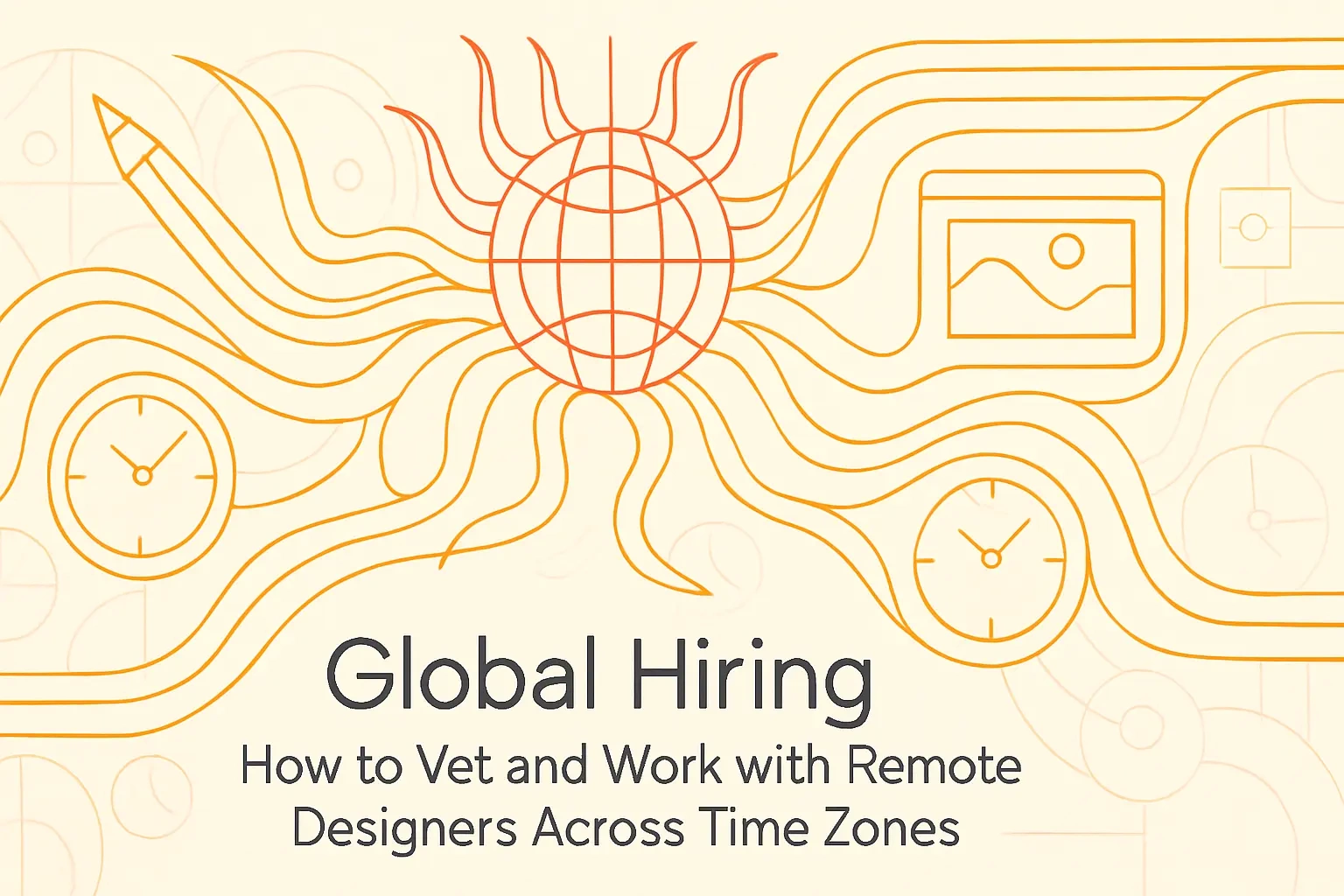Global Hiring: How to Vet and Work with Remote Designers Across Time Zones

Global Hiring: How to Vet and Work with Remote Designers Across Time Zones
The Advantages of a Global Design Team
Access to a Wider Talent Pool
Increased Diversity of Perspective
Potential for 'Round-the-Clock' Productivity
Vetting Remote Candidates: Skills to Look For
Exceptional Communication Skills
Demonstrated Self-Motivation and Autonomy
Experience with Remote Collaboration Tools
Strategies for Managing Time Zone Differences
Establish Core Overlapping Work Hours
Master Asynchronous Communication
Rotate Meeting Times
Building a Strong Remote Design Culture
Invest in Clear Documentation
Promote Trust and Transparency
Handle International Payments and Contracts
Conclusion
References
Global Hiring: How to Vet and Work with Remote Designers Across Time Zones
The design world has gone global, and that's great news for your business. When you're ready to find the perfect Figma designer, you're no longer limited to talent within commuting distance. You can tap into a worldwide pool of creative professionals who bring fresh perspectives and specialized skills to your projects.
But let's be real - hiring across borders and time zones isn't always smooth sailing. You'll face challenges like scheduling meetings when your designer is having breakfast while you're wrapping up dinner. Cultural differences can affect communication styles, and conducting thorough reference checks becomes even more crucial when you can't meet someone face-to-face. Plus, you'll need to think about practical assessments like Figma Design Tests that work in a remote context.
This guide cuts through the complexity. You'll learn how to spot the right remote design talent, manage time zone differences like a pro, and build a design team that feels connected despite the miles between them. Whether you're hiring your first remote designer or scaling up a distributed team, these strategies will help you navigate the global talent landscape with confidence.
The Advantages of a Global Design Team
Going global with your design team isn't just trendy - it's a smart business move that can transform how you approach creative projects. When you remove geographical boundaries, you unlock opportunities that simply don't exist when you limit yourself to local talent.
Access to a Wider Talent Pool
Think about it this way. If you're looking for a designer who specializes in healthcare UX and speaks fluent Spanish for your medical app expansion, what are the odds of finding that person within a 50-mile radius? Pretty slim. But expand your search globally? Suddenly you have access to thousands of qualified candidates.
The numbers speak for themselves. When you hire locally, you're fishing in a small pond. Go global, and you're casting your net into the ocean. You can find designers with incredibly specific skill sets - maybe someone who's an expert in designing for accessibility compliance, or a specialist in creating interfaces for emerging markets. These niche experts exist, but they might be living halfway around the world.
Cost flexibility is another huge advantage. A senior designer in San Francisco might charge $150 per hour, while an equally talented designer in Eastern Europe or South America might charge $50-70 for the same quality work. This isn't about finding the cheapest option - it's about finding the best value and being able to afford top talent that might otherwise be out of reach.
Increased Diversity of Perspective
Here's something that often gets overlooked: design isn't universal. What looks clean and minimal to Western eyes might feel cold and unwelcoming to users in other cultures. Color meanings vary dramatically - while white represents purity in Western cultures, it symbolizes mourning in many Asian countries.
A global design team brings these insights naturally. Your designer in Tokyo understands why Japanese websites often look "busy" to Western eyes - they're designed for a culture that values information density. Your designer in Brazil knows exactly why certain color combinations resonate with Latin American audiences. This isn't knowledge you can Google; it's lived experience.
This diversity leads to better products. When your team includes people from different backgrounds, someone will always spot the assumption you didn't know you were making. They'll question why your app's onboarding flow assumes users have unlimited data, or point out that your "intuitive" gesture might be offensive in certain cultures. These catches save you from expensive mistakes and help you create products that work for global audiences from day one.
Potential for 'Round-the-Clock' Productivity
The "follow the sun" model isn't just corporate buzzword bingo - it actually works. Picture this scenario: You're based in New York and brief your designer in London at 9 AM your time (2 PM their time). They work through their afternoon while you handle other tasks. By the time you wake up the next morning, the first draft is waiting in your inbox.
But it gets better. Add a designer in Singapore to the mix, and suddenly you have a design relay race. The London designer hands off work to Singapore, who then passes it back to you in New York. Projects that used to take weeks can be completed in days.
This doesn't mean burning people out with 24/7 demands. It's about smart scheduling and handoffs. Your team members work their normal hours - the magic happens in the overlap and the asynchronous collaboration. Critical feedback can be implemented overnight, iterations happen faster, and projects maintain momentum instead of stalling while waiting for time zones to align.
Vetting Remote Candidates: Skills to Look For
Finding a talented designer is one thing. Finding a talented designer who thrives in remote work? That's a different challenge entirely. Remote work demands a specific set of skills beyond creative ability, and knowing what to look for can save you from costly hiring mistakes.
Exceptional Communication Skills
In a remote setting, communication isn't just important - it's everything. You can't pop by someone's desk to clarify a point or read their body language in a meeting. Every interaction happens through written words, video calls, or recorded messages.
Start evaluating communication skills from the first touchpoint. How clear and organized is their portfolio presentation? Do they ask thoughtful questions about your project? Pay attention to their email responses. Are they prompt? Do they acknowledge your points and respond thoroughly, or do you find yourself asking follow-up questions constantly?
During interviews, watch for these green flags: They summarize discussions to confirm understanding. They proactively share updates without being asked. They write in clear, concise sentences without unnecessary jargon. They're comfortable admitting when they don't understand something and ask for clarification.
Red flags include vague responses, consistently delayed replies without explanation, or difficulty explaining their design decisions. If communication feels like pulling teeth during the hiring process when they're trying to impress you, imagine how it'll be during a stressful project deadline.
Demonstrated Self-Motivation and Autonomy
Remote designers need to be their own managers. They won't have someone looking over their shoulder or team energy to feed off when motivation dips. You need someone who can structure their own day, meet deadlines without reminders, and stay productive when working alone.
Look for evidence in their work history. Have they successfully completed long-term freelance projects? Ask about a time they had to manage a complex project independently. How did they organize their work? What happened when they hit obstacles?
Self-motivated designers often have side projects or continuous learning habits. They might maintain a design blog, contribute to open-source projects, or regularly share work on platforms like Dribbble or Behance. They set their own goals and follow through without external pressure.
During the interview process, give them a small test project with minimal guidance. See how they handle ambiguity. Do they make reasonable assumptions and move forward, or do they get stuck without constant direction? The best remote designers will ask clarifying questions upfront, then run with the project independently.
Experience with Remote Collaboration Tools
Technical fluency with remote tools isn't optional - it's essential. Your designer needs to hit the ground running with your tech stack, not spend their first week figuring out how to share files or join video calls.
Core tools they should know: Figma (or your design tool of choice) for collaborative design work. They should understand components, design systems, and real-time collaboration features. Slack or similar chat platforms for daily communication - including thread etiquette and when to use public versus private channels. Video conferencing tools like Zoom or Google Meet, including screen sharing and recording features.
Project management experience matters too. Whether it's Asana, Trello, Monday, or another platform, they should understand how to update task statuses, manage deadlines, and communicate progress through these systems. Bonus points if they're familiar with time tracking tools and documentation platforms like Notion or Confluence.
Don't just ask if they know these tools - dig deeper. How do they use Figma's commenting feature for design reviews? How do they organize their Slack communications to stay focused? Can they explain their workflow for version control and file organization? Their answers will reveal whether they've truly worked remotely or just used these tools casually.
Strategies for Managing Time Zone Differences
Time zones can be your biggest remote work headache or your secret productivity weapon. The difference lies in how you approach them. Smart teams turn the challenge of distributed schedules into an advantage, creating workflows that maximize everyone's peak hours while maintaining crucial connection points.
Establish Core Overlapping Work Hours
Finding the sweet spot where everyone's available requires some calendar gymnastics, but it's worth the effort. Start by mapping out your team's locations and identifying natural overlap windows. If you're in New York working with designers in London and Mumbai, you might find a golden hour or two in the early morning EST that works for everyone.
These core hours aren't about micromanaging - they're about creating predictable collaboration windows. Maybe it's 9-11 AM EST every Tuesday and Thursday. During these times, everyone knows they can get quick answers, hold design reviews, or tackle problems that need real-time discussion.
Be realistic about what you can achieve. A two-hour overlap is plenty for most teams if you use it wisely. Save these precious synchronous moments for high-value activities: design critiques, brainstorming sessions, or solving complex problems together. Don't waste them on status updates that could happen asynchronously.
The key is consistency and respect. Once you establish core hours, protect them fiercely. Don't schedule other meetings during this time, and make sure everyone understands these are sacred hours for team collaboration. But also respect boundaries - if someone's core hours mean they're working at 7 AM or 9 PM their time, keep meetings short and efficient.
Master Asynchronous Communication
Async communication is where remote teams either thrive or fall apart. The goal isn't to eliminate real-time interaction but to make 80% of your communication work without everyone being online simultaneously.
Start with documentation. Every project needs a home base - a single place where anyone can find the latest designs, feedback, and decisions. This might be a Figma file with detailed annotations, a Notion page with project specs, or a shared Google Doc with running notes. The tool matters less than the habit of keeping everything updated and accessible.
Video messages change the game. Tools like Loom let you record quick walkthroughs that teammates can watch when convenient. Instead of scheduling a meeting to explain design decisions, record a 5-minute video walking through your Figma file. Your colleague in Sydney can watch it over morning coffee, pause to take notes, and respond with their own video or written feedback.
Written communication needs extra attention in async environments. Be explicit about expectations and deadlines. Instead of "Can you look at this when you have time?" try "Please review the homepage design and leave comments by Thursday 5 PM your time." Include context that would be obvious in person. Summarize previous discussions, link to relevant files, and spell out next steps.
Create communication rhythms that work across time zones. Maybe designers post end-of-day updates that their colleagues see first thing in the morning. Or establish a 24-hour response time for non-urgent questions, so nobody feels pressured to work outside their normal hours.
Rotate Meeting Times
Fairness in scheduling builds team morale and prevents burnout. If your weekly design review always happens at 8 AM Pacific Time, your designer in Berlin is consistently taking calls at 5 PM, potentially cutting into family time. Over months, this imbalance breeds resentment.
Implement a rotation system that shares the inconvenience. This week's meeting might be early morning for the US team. Next week, it shifts to favor European time zones. The week after, it accommodates Asian team members. Yes, everyone takes a turn with an awkward meeting time, but everyone also gets turns with convenient slots.
Use scheduling tools that show multiple time zones simultaneously. When sending meeting invites, include times for all locations: "Design Review: 9 AM EST / 2 PM GMT / 7:30 PM IST." This small courtesy helps team members quickly see what they're committing to without mental math.
For critical meetings that happen regularly, consider running them twice. Hold the same design review at two different times to accommodate different regions. This requires more effort from meeting leaders but ensures nobody's consistently excluded from important discussions. Record these sessions so anyone who can't attend either slot can catch up.
Remember that flexibility goes both ways. If someone regularly takes early morning or late evening calls for the team, recognize this effort. Maybe they get to skip a different meeting or have more flexibility with their working hours on other days.
Building a Strong Remote Design Culture
Culture isn't about ping pong tables and free snacks. In remote teams, it's about creating an environment where designers feel connected, supported, and empowered to do their best work despite never sharing the same physical space. Building this culture takes intentional effort and the right systems.
Invest in Clear Documentation
Documentation is the backbone of successful remote design teams. Without it, you're constantly reinventing the wheel, answering the same questions, and watching projects derail due to misunderstandings. Good documentation isn't bureaucracy - it's freedom.
Start with a design system that lives and breathes. This isn't just a style guide gathering dust in a forgotten folder. It's a living document in Figma that shows every component, pattern, and principle your team uses. New designers can onboard themselves by exploring real, working examples. Design decisions have clear rationale documented alongside them.
Create project templates that capture institutional knowledge. Every new project should start with a brief that includes: project goals, success metrics, target users, constraints, timeline, and stakeholder map. This prevents the "I thought we agreed on X" conversations that plague remote teams.
Process documentation matters too. How does design review work on your team? What's the handoff process to developers? When should designers loop in stakeholders? Write it down. Not War and Peace - just clear, scannable guides that answer common questions. Update these regularly based on what's actually working, not what you think should work.
Make documentation accessible and searchable. A beautiful wiki that nobody can find information in is useless. Use consistent naming conventions, logical folder structures, and tools with good search functionality. The best documentation is the one people actually use.
Promote Trust and Transparency
Trust is the currency of remote teams. Without it, you get micromanagement, missed deadlines, and designers who feel like they're working in isolation. Building trust starts with focusing on outcomes, not activity.
Judge designers by the quality of their work and their ability to meet deadlines, not by how many hours they're "green" on Slack. Some designers do their best work at 2 AM. Others need long walks to solve design problems. As long as they're delivering great work and available during core hours, their schedule is their business.
Transparency keeps trust alive. Use project management tools where everyone can see project status, not just managers. When designers can see how their work fits into larger goals and timelines, they make better decisions. They also feel more invested in outcomes when they understand the bigger picture.
Share both successes and failures openly. When a design performs well in user testing, celebrate it with the whole team. When something doesn't work, discuss what everyone can learn. This creates psychological safety - designers know they can take creative risks without fear of harsh judgment if things don't work out.
Regular one-on-ones matter even more in remote settings. These aren't status updates - save those for async check-ins. Use this time to understand how designers are really doing. Are they feeling isolated? Overwhelmed? Excited about their work? These conversations build the human connections that keep remote teams strong.
Handle International Payments and Contracts
The logistics of international hiring can feel overwhelming, but getting them right from the start prevents major headaches later. Payment delays or contract confusion can quickly sour a good working relationship.
Choose payment platforms that work globally without excessive fees. Traditional bank transfers often come with high costs and long delays. Platforms like Wise, Payoneer, or even crypto payments can offer faster, cheaper alternatives. Discuss payment preferences upfront - your designer might have strong preferences based on their country's banking system.
Contracts need extra attention for international hires. Employment laws vary dramatically between countries. What's standard in the US might be illegal in Germany. Consider working with a global employment platform or legal service that specializes in international contracts. They can help you navigate issues like intellectual property rights, confidentiality agreements, and termination clauses that work across borders.
Be clear about currency and payment schedules. Will you pay in USD, their local currency, or something else? Who absorbs currency conversion fees? How do you handle exchange rate fluctuations for long-term contracts? Spelling this out prevents awkward conversations later.
Tax implications matter for both parties. In many cases, international contractors handle their own taxes, but you might need to provide specific documentation. Some countries have tax treaties that affect withholding requirements. Don't guess - get professional advice to ensure you're compliant with both your country's laws and theirs.
Consider time zone differences for payment schedules too. If payday falls on a Friday in your time zone, but it's already Saturday for your designer, payment might not process until their Monday. Small considerations like this show respect for your international team members and help build strong, lasting relationships.
Conclusion
Building a successful global design team isn't just about finding talented people in different time zones. It's about creating systems and culture that help those talented people work together seamlessly, despite the miles and hours between them.
The advantages are clear: access to specialized talent, diverse perspectives that strengthen your designs, and the ability to keep projects moving around the clock. But realizing these benefits requires thoughtful approaches to hiring, communication, and team building.
Start small if you're new to remote hiring. Bring on one international designer and refine your processes before scaling up. Pay attention to what works and what doesn't. Every team is different, and what works for a startup might not work for an enterprise.
Remember that the best remote design teams aren't trying to replicate office culture online. They're building something new - a way of working that leverages the unique advantages of distributed teams while addressing the challenges head-on. With the right approach, your next great designer might be halfway around the world, ready to bring fresh perspectives and exceptional work to your team.
The future of design work is global. By mastering the art of remote collaboration now, you're positioning your team to access the best talent and create products that resonate with users worldwide. The time zone challenges and cultural differences aren't obstacles - they're opportunities to build something stronger and more innovative than any single-location team could achieve.
References
Like this project









